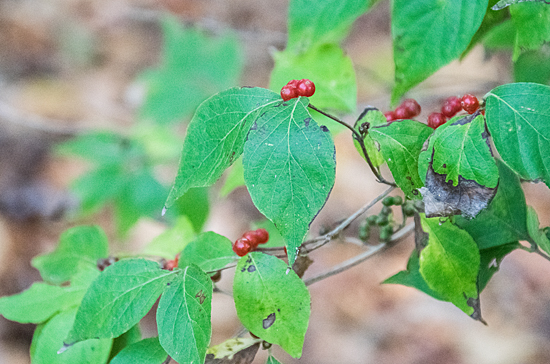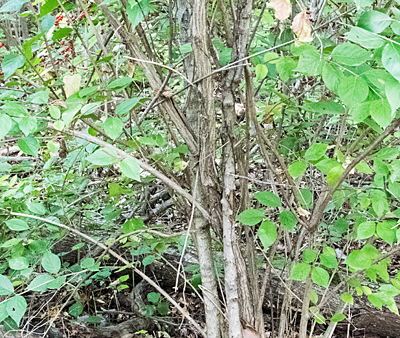Honeysuckle invades Hiestand Woods
DAVE MOSIER/independent editor
Compared to hurricanes, tornadoes, and the like, invasive honeysuckle isn’t a big deal; but in a nature preserve such as Hiestand Woods its effects are devastating to the wildflowers and other native habitat of the local preserve.

Seth Baker, executive secretary of The Van Wert County Foundation, which owns the property, said honeysuckle, an invasive species that has only been in the area for 12-15 years, is taking over Hiestand Woods, pushing out native species.
Curtis Young, Ohio State University Extension agent, said honeysuckle is “hugely competitive,” and noted it its long growing cycle quickly allows it to dominate a woods’ understory, or undergrowth.
“One of the challenges with honeysuckle is that it is the first to leaf out in the spring and the last to drop its leaves in the fall,” Young noted.
That’s a big problem for native wildflowers that depend on early blooming before tree foliage shades them out, since the honeysuckle, which leafs out even earlier, prevents the wildflowers from getting the sunshine needed to grow.
Baker called an area such as Van Wert is a “perfect storm” for honeysuckle, since it is a mix of urban and rural habitat. Amateur gardeners tend to plant honeysuckle because it grows quickly and provides quick cover. Birds then help the plant proliferate by eating the berries and then spreading seeds in woodland areas.
Young said honeysuckle has been popular with gardeners because it is a very attractive plant and smells great.
“The irony of this is, when it’s in bloom, the honeysuckle is absolutely gorgeous and its aroma is tremendous,” he said.

In addition to pushing out native plant species, the OSU agent noted the plant is a threat to songbirds as well, since it is attractive as a nesting plant, but provides easier access to a bird’s nest for predators. Young said the plant’s berries also can be a problem for cardinals. The brilliance of a male cardinal’s plumage is supposed to show its genetic superiority, but eating honeysuckle berries can also improve the plumage of inferior birds, resulting in offspring more susceptible to disease and other issues.
The Emerald Ash Borer invasion has also aided honeysuckle’s expansion, because the death of ash trees open up areas of a woods to the sun — and honeysuckle grows best when exposed to direct sunlight.
Baker said Hugh Kocab and his YMCA staff are responsible for the upkeep of the woods, and are involved in eradicating the honeysuckle from the property, using a “slash and spray” method in which the plants are cut and then sprayed with herbicides.
Young and Baker both noted that the process can take five years before the honeysuckle is entirely eliminated, and then an area has to be checked on an annual basis to make sure the plant doesn’t re-establish itself.
“It’s a really bad player,” Young said. “It will be a continuous battle and it takes major dedication to do it.”
Baker noted that, because of the time and effort involved, eliminating the honeysuckle from Hiestand Woods will be an expensive process for the foundation, but necessary to preserve its native flora and fauna.
POSTED: 10/03/17 at 8:02 am. FILED UNDER: News







